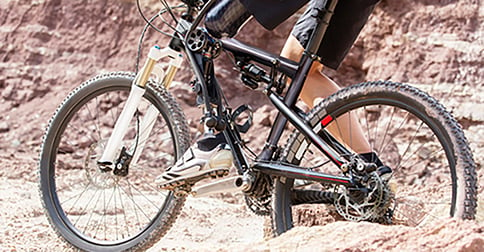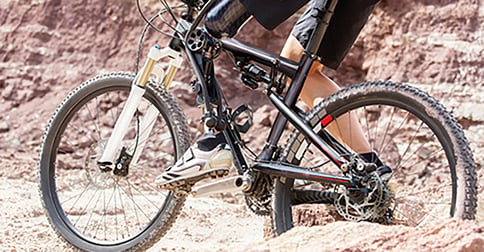Cycling is a fun, low-impact exercise that can help you rebuild strength and maintain your fitness after losing a leg. But if you’ve had an above or below knee amputation, how do you continue to ride your bike?
Read on for tips!
The Bicycle
One of the most common problems associated with cycling after amputation is that a prosthesis doesn’t stay on a flat pedal very well. Instead, it will slide off, which makes riding a bike very difficult.
As you’re starting to get back into cycling, the best thing to do is to have a flat pedal without clip-ins on the side with your whole leg (for single amputees) while you get used to clipping in on the side with the prosthesis. Sometimes, a clip-in pedal allows for tension adjustment, which will make it harder or easier to unclip. Make sure you set this on the easiest position.
Also, a crank arm shortener may help decrease the degree that your knee has to bend, which can make things a lot more comfortable and efficient for you. Crank arm shorteners allow you to place the pedal in a variety of locations so that you can find the best position and, hopefully, reduce the amount of socket pinch behind the knee or at the hip. You can find a crank arm shortener online or at your local bike shop.
The Prosthesis
Another issue that comes with cycling after amputation is that the heel of your prosthesis may hit the crank arm. If that happens, the first thing to try is asking your prosthetist to help you adjust your alignment when getting on and off the bike.
For an above the knee socket, you can also see about having an older socket cut down to give you more comfort on the bicycle seat. Using a waist belt can help by giving you improved rotation control and suspension.
Some knee prostheses have a “free swing” setting, which can make pedaling much more efficient. Just make sure you know how to change the setting as you get on and off the bike.
Getting On and Off Your Bike
You’ve prepared your bike and your prosthesis -- you’re ready to go! Well, almost. First, make sure you are adept at getting on and off the bike. This needs to be a smooth process that you feel comfortable with before you take off down the road. Have someone spot you until you’ve got the hang of it.
The best way to get on your bike is to swing your prosthetic side (or your weaker side, if you are a double amputee) over the bike and then secure it into the pedal. To get off the bike, set down your sound leg (or your stronger side) first. You’ll have to twist a bit to unclip your prosthesis from the pedal; sometimes it helps to lean the bike over a little after setting your sound foot on the ground.
Once you feel confident getting on and off your bike, you’re ready to take your first ride! Just be careful and exercise good judgment. Start slow, and go out for a short time. You can increase your time and speed little by little until you build up to your desired level. Soon, cycling after amputation will feel natural, and you’ll be spinning down the street whenever you want!
BioTech Can Help You Get There!
Here at BioTech, our passionate, dedicated team is here to help you reach all your athletic goals. We know the possibilities, and we are here to make them your reality! Contact us today for all your prosthetic and orthotic needs.

